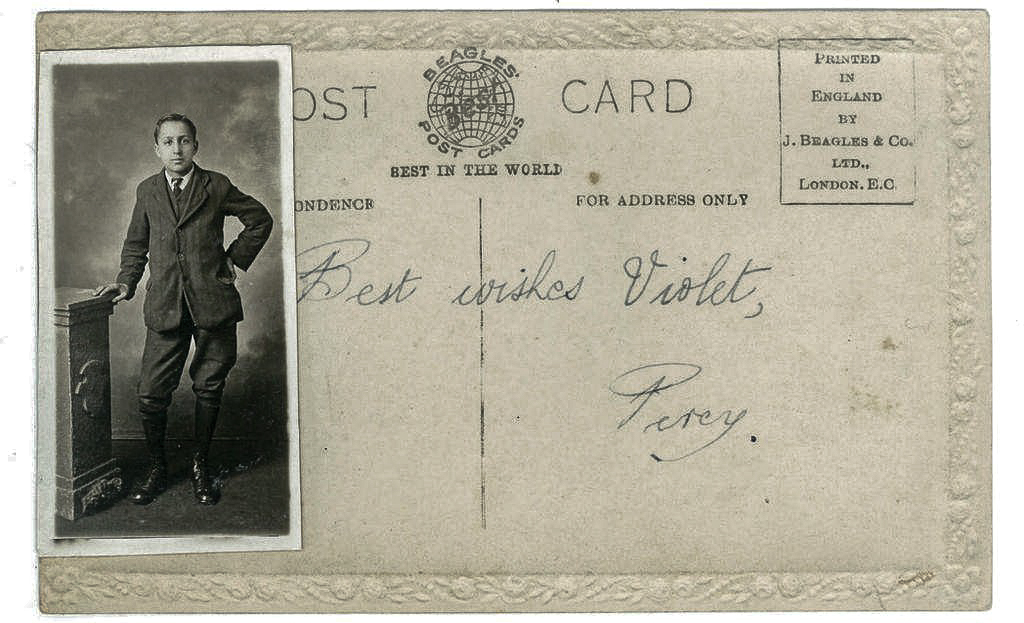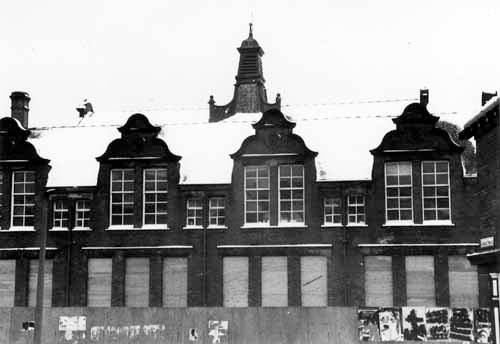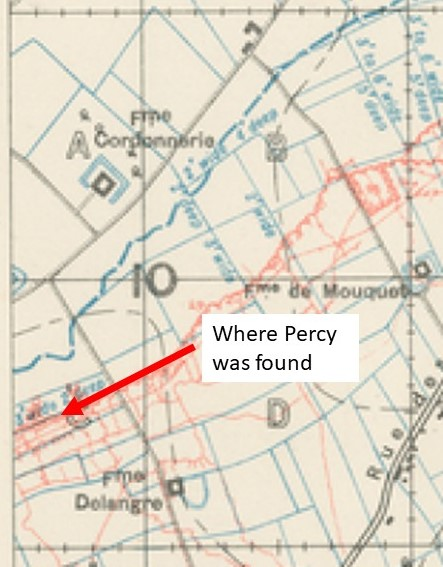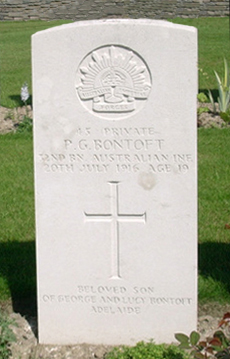
Percy George BONTOFT
Eyes dark, Hair brown, Complexion dark
Percy Bontoft, “somewhere” in France
In preparing this story, we acknowledge the work of David Ward (great-great-nephew of Percy Bontoft) in his article I Only Know That You Are Somewhere published in Traces, Uncovering the Past, Volume 2, 2018.
Percy George Bontoft, the fourth of Lucy (nee Frost) and George’s four children, was born in Leeds, England on 28 June 1897. His older siblings included Ethel, Horace and Violet. Percy’s early education was at the Harehills Primary School, a “Board” School, less than a half mile from where he lived. After his schooling, he became a carpenter like his father who was a joiner.
In June 1914, George, Lucy and their family migrated to South Australia with Percy turning 17 years old just prior to their arrival in Australia. Even their eldest daughter and her husband, who had married in the UK in 1910, made the move. The families settled in the Goodwood area, just south of the Adelaide CBD.
The call to war
In July 1915, at just 18 years old, Percy answered the call to the war in Europe as an Australian soldier. He was assigned to the newly formed 32nd Battalion, A Company. A and B Companies were to be from South Australia and C and D from Western Australia. There was much fanfare about the new battalions, with gatherings, community support, such as the Cheer-up Society and reviews by the South Australian Premier.
The men from WA arrived in Adelaide at the end of August and training for all continued there. Percy departed for Egypt on 18 November 1915 on the troop ship HMAT A2 Geelong. As reported in the Adelaide Register:
“The 32nd Battalion went away with the determination to uphold the newborn prestige of Australian troops, and they were accorded a farewell which reflected the assurance of South Australians that that resolve would be realized.”
They arrived in Suez on 14 December 1915 and settled into El Ferdan just before Christmas. The troops also spent time in Ismalia, Tel El Kabir, Duntroon Plateau, Ferry Post and Moascar, continuing their training all along. During their time in Egypt, the 32nd also had the honour of being inspected by H.R.H. Prince of Wales though conditions were less than ideal:
One soldier’s diary complained of being “sick up to the neck of heat and flies”, of the scarcity of water during their long marches through the sand, and describing some of the food as “dog biscuits and bully beef”
The diarist mentioned good times as well with swims, mail from home, visiting the local sights and the like. You can read more about Theodor Pflaum here https://fromelles.info/soldiers/327-2nd-lieutenant-theodor-milton-pflaum/
To the Western Front
After spending six months in Egypt, the call to support the British Expeditionary Force on the Western Front came in mid-June. The 32nd left from Alexandria on the ship Transylvania on 17th June and arrived at Marseilles, France on 23rd June 1916.
A letter that Percy wrote to his sister, Violet, when he was aboard the troopship en route to France, sometime in June 1916, reveals a hint of melancholy and perhaps portent:
“Dear Violet,
It is our last Sunday on the water, and we have just had our last service on board. We have some jolly good singing out here, and it would just suit Dad. I hear the post on board is closed now, so I will not be able to post this until I land. Still, it is a good opportunity for writing, my reason for doing so is, I have remembered it will very soon be your 21st, and I did’nt [sic] want to let it pass as though it was nothing. You will be able to tell me off when I come back ‘eh’, I certainly wish you the best of health, and a happy life, which is to my mind, the best I could wish you. If you were going to be married, I would present you with a floor cloth, but under the circumstances it is not worth while [sic]. We are having a good voyage but a rather dull time of it.
Au Revoir,
I remain your loving brother, Percy.”
Percy’s great-great-nephew, David Ward, found that correspondence like this to his ‘Aunty Vi’ (a ‘living connection’ and a generous aunt remembered from David’s childhood) allowed him to uncover more of Percy’s story by revealing fragments of history captured in treasured family letters held by his grandmother.
After arriving in Marseilles, the 32nd departed by train for the two-day trip to Hazebrouck, about 30 kilometres from Fleurbaix. Their route took them to a station just out of Paris, within sight of the Eiffel Tower, then through Bologne and Calais, with a view of the Channel, and finally to St Omer and Hazebrouck.
Theodor Pflaum (No. 327) wrote about the trip in his diary:
“The people flocked out all along the line and cheered us as though we had the Kaiser as prisoner on board!!”
Wesley Choat (No. 68), for one, was glad to be out of Egypt, but he was well aware of what laid ahead:
“The change of scenery in La Belle France was like healing ointment to our sunbaked faces and dust filled eyes. It seemed a veritable paradise, and it was hard to realise that in this land of seeming peace and picturesque beauty, one of the most fearful wars of all time was raging in the ruthless and devastating manner of "Hun" frightfulness”.
The troops then settled into nearby Morbecque, and training continued with a focus on bayonets and the use of gas masks.
The 32nd moved into the front line on 14 July and on the 16th were into the trenches for the first time, only three weeks after arriving in France. On July 17th, they were reconnoitring the trenches and cutting passages through the wires, preparing for an attack, but it was delayed due to the weather.
D Company’s Lieutenant Sam Mills’ letters home were optimistic for the coming battle:
“We are not doing much work now, just enough to keep us fit—mostly route marching and helmet drill. We have our gas helmets and steel helmets, so we are prepared for anything. They are both very good, so a man is pretty safe.”
Percy also wrote just three days before the Battle of Fromelles, this time to a relative or friend, Edith Osborne, in Yorkshire:
“…we are here at last and perhaps I shall soon be there – I hope so (By Jove)…We have seen a bit of the real thing now and…can fear it. (about time eh) We have now been enlisted 12 months. I must thank you for the cigarettes which arrived on my 19th birthday. (28.6.1916)…”
Into Battle
In the morning of the 18th, A and C companies were into the trenches to relieve B and D companies. B and D rejoined them on the 19th. All were in position by 5.45pm on the 19th and the charge over the parapet began at 5.53pm. Percy’s A Company, 2nd Platoon was in the first wave of the charge.
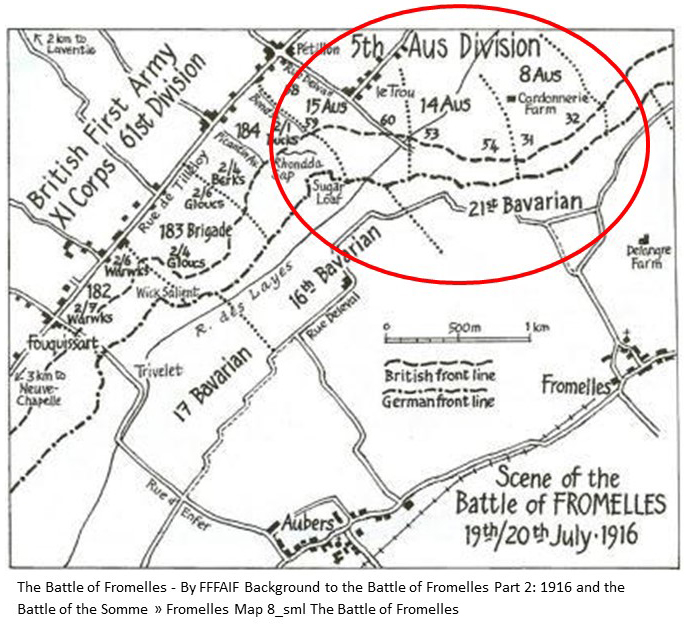
The 32nd was successful in their initial assaults and by 6.30pm were in control of the German’s first line system (see sketch map trench B), which was described as “practically a ditch with from 1 to 2 feet of mud and slush at the bottom” Source: AWM Diaries
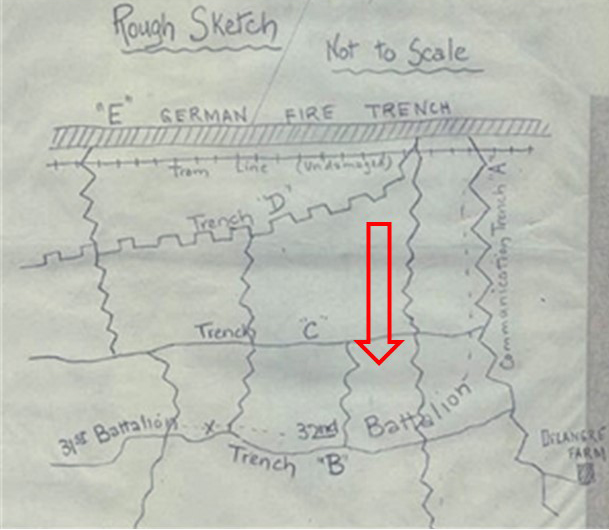
By 8.30pm, their left flank had come under heavy bombardment with high explosives and shrapnel. Return bombardment support was provided and the troops were told that “the trenches were to be held at all costs”.
Fighting continued through the night. At 4.00am, the Germans began an attack from the Australian’s left flank, bombing and advancing into communication trench A (see sketch map). Given the Australian advances that had been made earlier, the rear trench E had been left almost empty, which enabled the Germans to surround the soldiers of the 32nd.
Up ahead, the Australians made a further charge at the main German line beyond trench B, but they were running low on grenades. There was also machine gun fire from behind from the emplacement at Delangre Farm and the Australians were so far advanced that they were getting shelled by both sides.
A mate, Private William Herbert COLLINS (No. 76), said Percy had been badly wounded from machine gun fire during the night. Several others had also written their families that Percy had been wounded.
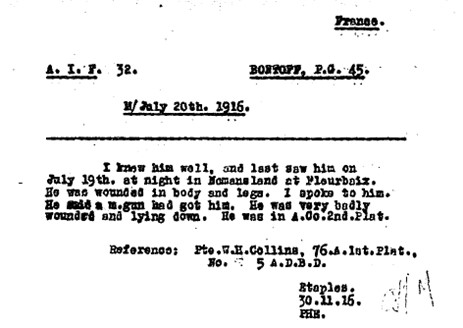
When the call to withdraw came, having been surrounded by the Germans, the surviving soldiers had to fight their way back through the Germans to get to their own lines - not much hope for a badly wounded soldier like Percy.
What was left of the 32nd were back in their own lines by 7.30am on the 20th. The toll on the battalion was devastating – 718 casualties, 90% of their effective strength. Percy was not among those who returned.
A second report on Percy’s involvement in the battle is from the Adjutant of the 32nd Battalion, Reynold H. Robinson. He spoke very highly of Percy and of his advances in the battle, but acknowledged his likely fate.
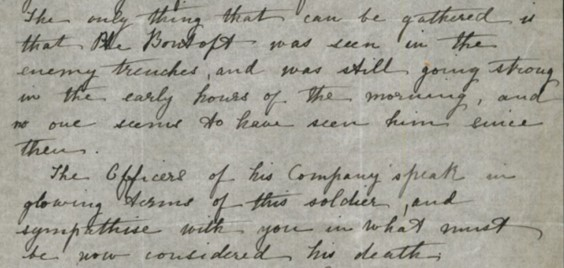
Letter to Percy’s family from Reynold H. ROBINSON, adjutant of the 32nd Battalion
Lieutenant Sam Mills survived the battle and his letters home highlighted the bravery of the men:
“They came over the parapet like racehorses……… However, a man could ask nothing better, if he had to go, than to go in a charge like that, and they certainly did their job like heroes."
The family waits in hope
After the Battle, the Army was in contact with the family, but the messages were mixed:
- 13 Aug 1916: Family advised Percy wounded
- 5 Sep 1916: Red Cross letter – notes severely wounded
- 15 Sep 1916: Family advised Percy wounded, not severely, but no hospital information available
- 4 Oct 1916: Army report that Percy missing, not wounded
- Oct/Nov 1916: Other families received news about wounded sons who had been able to crawl back and Percy’s mother Lucy remained firm that Percy DID survive
- 28 Nov 1916: Army’s response to Lucy’s letter that Percy was now “missing”, not wounded
- 7 Dec 1916: Red Cross advised that a soldier had been told that a pal of Percy’s had received a letter from Percy and that he was doing well in a hospital in England
- Sep 1917: Court of Enquiry in the Field – Percy found to have been Killed in Action
- Sep 1917: A Minister visited the family, but, in a letter to the Army, Lucy remained adamant that Percy was alive, “do you think you get all the prisoners names, ‘I think not’”
- Oct 1919: Captain Mills’ post-war prisoner of war search - ‘No trace Germany’

23 November 1916 letter from Percy’s mother to the Army feeling sure within herself that he was not killed.
The most poignant letter, from Violet, is dated 29 August 1916, more than five weeks after the Battle of Fromelles:
“Dear Percy,
…Now I am writing this letter to you without the slightest knowledge of your address. I only know that you are ‘somewhere’, whether in France or England remains to be seen. Wherever you are, remember that we think of you frequently, and pray for your safe return.
A fortnight ago, we received from Melbourne a telegram advising us that you were wounded, and informing us that as soon as further particulars were received we should be notified.
Up to the present we have not heard anything further, so we trust that ‘No news is good news’. One hardly knows what to hope for. If we hope that your wound is very slight, we know that that would mean that you would soon return to the front. On the other hand, we certainly do not wish your wound to be of a serious nature so I think we had better just hope for the BEST. Then we are on the safe side.
It is 10 o’clock, so I must say goodnight and ‘good luck’.
Your loving sister,
Violet.”
Despite the family’s persistent optimism, Percy was not found.
Finally, Closure
A search for wounded and dead soldiers was made immediately post-battle, though there was no cease-fire to assist in this effort. Given the heavy artillery fire during the battle, they “found the land all ploughed up” and soldiers could have been buried as a result of the shelling.

Letter from Lucy dated 11 September 1917 regarding a search for Percy
Post War, the Commonwealth War Graves Commission made extensive searches for missing soldiers and Percy’s family was finally advised in 1925 that his remains were recovered. The detail of where he was found was very much in line with the information from the battle.
Identification would have been challenging. The body had been buried for nearly nine years and the grave included two identifiable items. The first was a partial identification disc with only the following letters partly legible and interpreted as ‘?ONTOR?’ – thought to be Bontoft. The second item was a knife inscribed ‘R. Brooks’.
The R. Brooks is believed to be Robert Brooks who was in the 32nd Battalion (A company, the same as Percy), 20 years old and originally from London. He was taken as a prisoner of war during the battle. Robert and Percy were almost certainly friends, both being in A company and of similar age and backgrounds, and this friendship could explain why Robert’s knife was where Percy was found.
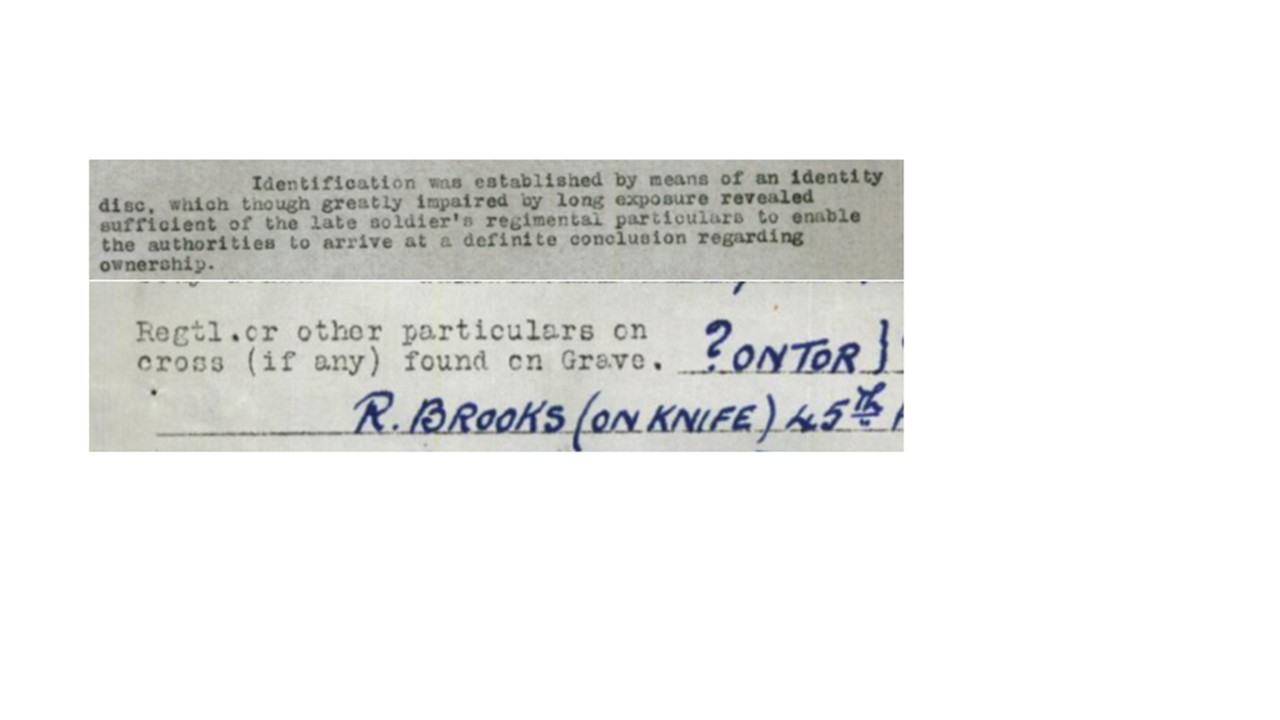
Percy is buried at Bedford House, British Cemetery Extension No. 4, Plot 6, Row C, Grave 17, Ypres, Belgium.
A day before the ninth anniversary of Percy’s death, his father George Bontoft wrote that, ‘it is a great relief to know that his remains have at last been found and reverently interred’.
His family also received Percy’s military service medals including the 1914-15 Star, Victory and British War Medals as well as a Memorial Scroll and a Memorial Plaque. His name is also commemorated at:
- Panel 120, Australian War Memorial, Canberra, ACT
- Adelaide National War Memorial, Adelaide, SA
- Goodwood St George Anglican Church Memorial Tower, Adelaide, SA
- Unley Arch of Remembrance, Adelaide, SA, and
- Unley Town Hall WW1 Honour Board, Adelaide, SA
Percy’s great-great nephew, David Ward, sums up his search for Percy’s war experience:
I have found more information than I anticipated, but also more questions. For now, I leave a poppy against Percy’s name on the Roll of Honour at the Australian War Memorial. The research process has been rewarding, and the brief and tragic war service of Private P.G. Bontoft is not forgotten.”
The Fromelles Association would love to hear from you

Contacts
(Contact: carla@fromelles.info or geoffrey@fromelles.info).
(Contact: army.uwc@defence.gov.au or phone 1800 019 090).
Donations
If you are able, please contribute to the upkeep of this resource.
(Contact: bill@fromelles.info ).
